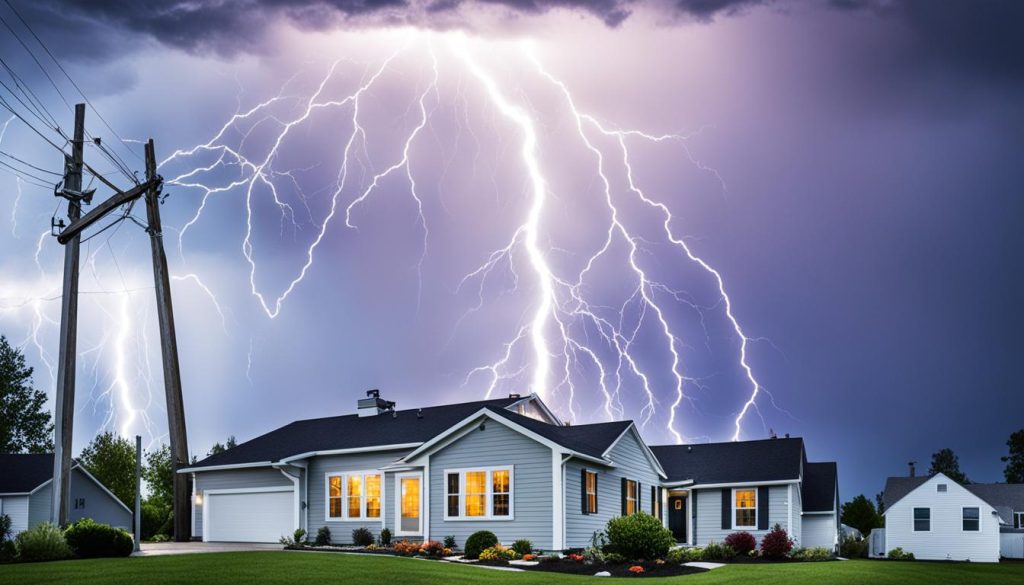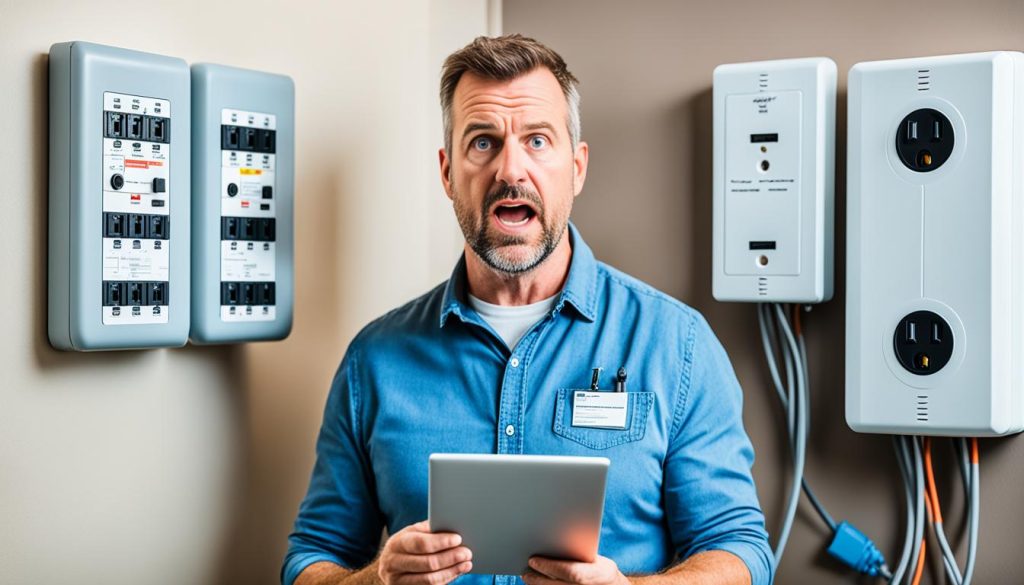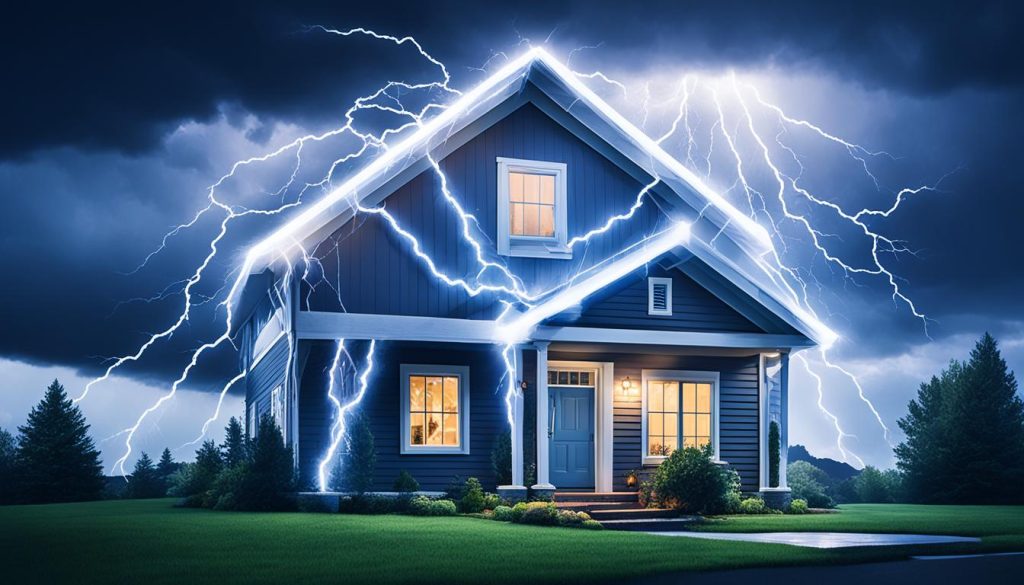Do you need a whole house surge protector to protect your home and electrical devices? The answer is a resounding yes! Many homeowners mistakenly believe that plugging their computer into a power strip is enough, but this is rarely the case. Power surges can occur due to various factors such as lightning strikes, downed power lines, changes in electricity use, or the cycling on and off of appliances. These surges can cause significant damage to appliances, electronics, and delicate circuitry, leading to costly repairs or replacements.
While lightning-induced surges are the most powerful and feared, it’s important to note that most surge-related damage is caused by other factors. Whole-house surge protectors offer a comprehensive solution to surge protection, with a main unit to handle big power spikes and individual circuit protectors for vulnerable appliances and devices. Investing in a whole house surge protector is a smart move to safeguard your home and avoid the financial losses associated with power surges.
Key Takeaways:
- Whole house surge protectors are essential for protecting your electrical devices from power surges.
- Power surges can result from various factors like lightning strikes, downed power lines, and changes in electricity use.
- A whole house surge protector diverts excess voltage to the ground, preventing damage to appliances and electronics.
- Surge protectors should be properly installed and meet relevant safety standards for optimal protection.
- Investing in surge protection can save you from costly repairs or replacements in case of a power surge.
How do Surge Protectors Work?
Surge protectors act like pressure-relief valves for electricity. They divert excess voltage to the ground, allowing electric current to flow through them normally. When there is a surge in voltage, the surge protector reacts within nanoseconds to divert the excess energy.
Whole-house surge protectors are hard-wired to the service panel and should be rated to stop at least a 40,000-amp surge. They include features such as thermal fuses and indicator lights to signal when they have experienced a surge. Circuit protectors, on the other hand, are plug-in devices that protect individual appliances and devices. They should meet UL Standard 1449, have a clamping voltage of 400 volts or less, and absorb at least 600 joules of energy.
It is important to ensure that surge protectors are properly installed and that the house wiring is grounded for them to work effectively.
How Surge Protectors Divert Excess Voltage
When an electrical surge occurs, the surge protector detects the increase in voltage and activates its internal components to redirect the excess energy. The surge protector’s metal oxide varistor (MOV) or gas discharge tube (GDT) plays a key role in this process.
MOV-based surge protectors use a voltage-clamping device that diverts excess voltage to the ground when the voltage exceeds a certain threshold. The MOV is made of a semiconducting material that can conduct electricity when the voltage is below its clamping voltage, allowing normal current flow. However, when the voltage reaches the clamping level, the MOV becomes conductive and shunts the excess voltage to the ground, safeguarding the connected devices.
GDT-based surge protectors, on the other hand, use a gas-filled tube that ionizes when the voltage rises above a specific threshold. This ionization provides a low-resistance path to the ground, effectively diverting the excess voltage. Once the voltage returns to normal, the gas tube deionizes and the surge protector resumes its normal operation.
Surge protectors act as a vital barrier between your electronic devices and harmful power surges. By intercepting and redirecting excessive electrical energy, they shield your valuable appliances from potential damage or destruction.
It’s important to note that surge protectors have a limited lifespan and can wear out over time or after experiencing multiple surges. Regularly inspecting surge protectors and replacing them when necessary ensures continued protection for your electronic devices.
| Surge Protector Type | Key Features |
|---|---|
| Whole-House Surge Protector |
|
| Circuit Protector |
|
The Importance of Surge Protection for Your Home
Surge protection is crucial for safeguarding your home and its electrical system from potentially costly damages. When a power surge occurs, it can wreak havoc on your appliances, electronics, and even pose a risk of starting fires. That’s where surge protectors come in, mitigating the risk of damage by diverting excess voltage and maintaining the safety of your electrical system.
Whole-house surge protectors offer comprehensive protection for your entire home, ensuring that all appliances and devices are shielded from power surges. These devices act as the first line of defense, diverting excessive voltage and preventing it from damaging your valuable electronic equipment. Additionally, individual circuit protectors provide targeted protection for specific appliances and devices, adding an extra layer of security.
Investing in surge protection provides peace of mind, knowing that your home and electronic investments are safe from potential power surges and the financial losses they can cause. By taking this proactive step, you can avoid the inconvenience and expense of repairing or replacing damaged appliances and electronics.
Protect your home and belongings by investing in reliable surge protection for your electrical system today. It’s a small but impactful measure that can save you from significant headaches and costs in the long run.
The Benefits of Surge Protection
Let’s take a closer look at the advantages of surge protection for your home:
- Safekeeping of Appliances and Electronics: Surge protectors divert excess voltage, protecting your appliances, electronics, and delicate circuits from damage.
- Fire Prevention: Power surges can sometimes lead to electrical fires. Surge protectors minimize this risk by regulating the voltage and ensuring that your electrical system remains safe.
- Peace of Mind: Knowing that your valuable electronic equipment is safeguarded against power surges provides peace of mind, particularly during severe storms or grid outages.
- Long-Term Savings: While whole-house surge protectors may have a higher upfront cost compared to traditional power strip surge protectors, they can save you money in the long run by preventing expensive repairs or replacements.
Don’t leave the protection of your home and electronics to chance. Invest in surge protection and enjoy the safety, peace of mind, and potential savings it brings.

| Key Points | Benefits |
|---|---|
| Protection against power surges | Safeguards appliances and electronics |
| Fire prevention | Reduces the risk of electrical fires |
| Comprehensive whole-house protection | Ensures all devices are shielded |
| Targeted protection for specific devices | Provides an extra layer of security |
| Peace of mind | Assurance that your electronic investments are safe |
| Inexpensive long-term solution | Prevents costly repairs or replacements |
Choosing the Right Whole House Surge Protector
When it comes to protecting your home from power surges, choosing the right whole house surge protector is essential. Here are some factors to consider:
1. Surge Rating
Ensure that the surge protector you select is capable of handling at least a 40,000-amp surge. This will provide optimal protection for your home’s electrical system.
2. Additional Features
Look for surge protectors that come with additional features such as thermal fuses and indicator lights. A thermal fuse acts as a backup protection mechanism, cutting off power in the event of a surge. Indicator lights alert you when the surge protector has experienced a surge, indicating the need for replacement or further investigation.
3. Compatibility
Determine whether your home requires separate surge protectors for power, phone, and cable lines. Some surge protectors are designed to accommodate all three, while others may require separate units for each. Consider your home’s specific needs when making your decision.
4. Professional Installation
It is highly recommended to have a licensed electrician install your whole house surge protector. They have the expertise to ensure proper installation and can assess any potential issues specific to your home’s electrical system. The cost of installation may range from $500 to $700, depending on the size of your house and the complexity of the installation.
5. Brand Reputation
Research reputable brands and models before making a final decision. Look for customer reviews and ratings to gauge the effectiveness and reliability of the surge protector. Choosing a trusted brand will help ensure the longevity and efficiency of your surge protection system.

By taking these factors into account, you can make an informed decision and choose a whole house surge protector that provides optimal protection for your home and valuable electronic devices.
Advantages of Whole House Surge Protectors
Whole house surge protectors offer several advantages for homeowners. Here are the key benefits:
Comprehensive Protection:
Whole house surge protectors provide comprehensive protection for your entire electrical system. They ensure that all appliances and devices in your home are safeguarded against power surges. With a whole house surge protector, you can have peace of mind knowing that your valuable electronics are protected.
Prevent Costly Damages:
By diverting excess voltage to the ground, whole house surge protectors prevent costly damages to your electronics and appliances. They act as a shield, keeping your devices safe from power surges that can fry circuit boards and cause irreversible damage. Investing in a whole house surge protector can save you money on expensive repairs or replacements.
Continuous Protection:
Whole house surge protectors offer continuous protection for your home, even during severe storms or grid outages. You don’t have to worry about unplugging all your devices or relying on power strips during a storm. The whole house surge protector ensures that your home is protected, regardless of external factors.
Long-Term Savings:
While whole house surge protectors may have a higher upfront cost compared to traditional power strip surge protectors, they provide long-term savings. By preventing damages to your electronics and appliances, a whole house surge protector eliminates the need for costly repairs or replacements. It is a wise investment to protect your home and valuable electronic equipment.
| Advantages of Whole House Surge Protectors | Benefits |
|---|---|
| Comprehensive Protection | Safeguards all appliances and devices |
| Prevent Costly Damages | Diverts excess voltage, preventing electronics and appliance damage |
| Continuous Protection | Ensures protection during storms and grid outages |
| Long-Term Savings | Eliminates the need for expensive repairs or replacements |
Overall, the advantages of whole house surge protectors make them an essential component of your home’s electrical system. With their comprehensive protection, prevention of costly damages, continuous protection, and long-term savings, investing in a whole house surge protector is a smart decision to protect your home and valuable electronic equipment.

When to Install a Whole House Surge Protector
To ensure the safety and protection of your home’s electrical system, it is highly recommended to install a whole house surge protector as soon as possible. Power surges can strike at any time and can cause significant damage within seconds. Whether it’s a lightning strike or fluctuations in electricity use, being proactive and having surge protection in place is crucial.
If you’ve recently invested in new appliances or electronic devices, it’s even more advisable to install whole-house surge protection. These valuable investments can be susceptible to damage from power surges, and a surge protector will help safeguard them. Don’t wait for a power surge to wreak havoc on your home and valuable equipment; take the necessary steps to protect them today.
Delaying the installation of surge protection puts your home and belongings at risk. The cost of repairing or replacing damaged electronics and appliances can be significant, not to mention the inconvenience and disruption caused. By installing a whole house surge protector, you’ll have peace of mind knowing that your home and valuable equipment are shielded from power surges and potential financial losses.
FAQ
Do I need a whole house surge protector?
Yes, having a whole house surge protector is crucial to protect your electrical devices from unexpected power surges. Power surges can cause significant damage to appliances, electronics, and delicate circuitry. Whole-house surge protectors offer comprehensive protection for your entire home and prevent costly losses.
How do surge protectors work?
Surge protectors act like pressure-relief valves for electricity. They divert excess voltage to the ground, allowing electric current to flow through them normally. When there is a surge in voltage, the surge protector reacts within nanoseconds to divert the excess energy and protect your devices.
What is the importance of surge protection for your home?
Surge protection is crucial for safeguarding your home and its electrical system from costly damages. Power surges can harm appliances, electronics, and even start fires. Surge protectors help mitigate the risk of these damages by diverting excess voltage and ensuring that the electrical system remains safe.
How do I choose the right whole house surge protector?
When choosing a whole house surge protector, consider factors such as its surge rating, features like thermal fuses and indicator lights, and compatibility with power, phone, and cable lines. It is essential to research and choose a reputable brand and model for effective surge protection.
What are the advantages of whole house surge protectors?
Whole house surge protectors offer comprehensive protection for your entire electrical system, safeguarding all appliances and devices. They prevent costly damages to electronics and appliances, provide peace of mind during storms or grid outages, and offer long-term savings by preventing expensive repairs or replacements.
When should I install a whole house surge protector?
It is recommended to install a whole house surge protector as soon as possible to ensure the safety and protection of your home’s electrical system. Delaying the installation puts your home and valuable equipment at risk. Don’t wait for a power surge to cause damage; take the necessary steps to protect your home today.


